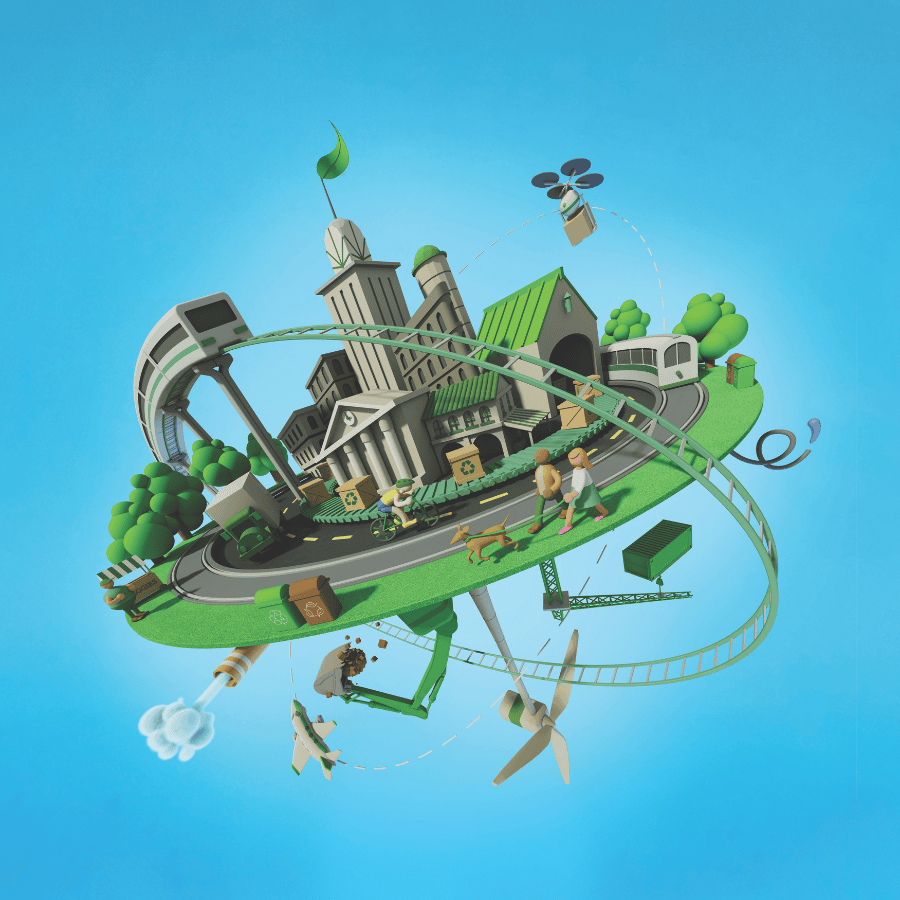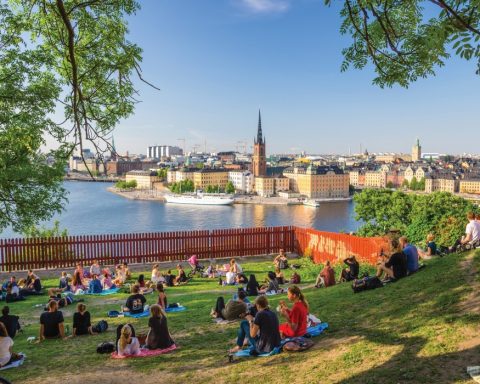In the summer of 1980, our family travelled to the Black Forest of southern Germany to visit friends my parents had made a decade earlier while working in East Africa. The family lived in a 17th-century farmhouse in a valley that appeared to be torn straight out of a Brothers Grimm fairy tale. Geraniums spilled over balconies, slate roofs stretched down to the ground, and roosters crowed from the farm next door.
Inside their postcard of a home, the family enjoyed a lifestyle not so different from ours in North Toronto. Except for one thing: nothing in that house was wasted. Once a month, a garbage truck trundled down the ribbon of road running through the valley and the four-member family contributed their monthly yield: one small shopping bag of trash.
An environmentalist at heart, my mother came home bursting with inspiration. Henceforth, we were going to shoehorn our North Toronto lifestyle into Black Forest standards of sustainability. But try as we might – recycling scraps of cellophane, crushing cardboard boxes, patching pants – it couldn’t be done. Not even close. Our weekly garbage bins – like those of our neighbours – remained full to overflowing, and when Toronto introduced recycling bins in 1988, they were too.
Cities are incredibly wasteful places. They generate mountains of garbage: discarded items of all kinds, many still containing most of their value. And then there’s the waste that results from poor policy and planning: roads clogged with single-driver SUVs, suburbanites commuting hours to work, the unhoused having to pitch tents in parks for lack of affordable housing. Wastes of time and space, of human potential and planetary health.
Among economists, there’s a growing consensus that the inherently wasteful linear model that has defined industrial production and economic growth for the last two centuries – of take, make, use and lose – is no longer tenable. In its stead, a circular model is being proposed, one that “uses less materials, for longer, again and again,” in the words of Joanne Gauci, a senior policy advisor to Metro Vancouver. In 2013, Metro Vancouver launched the National Zero Waste Council, which aims to promote circularity in Canadian cities by bringing municipal leaders together with representatives of government, business, academia and the non-profit sector.
It’s a global trend; Swiss-based sustainable building materials firm Holcim, which has developed a “Circular Cities Barometer,” counts Delhi, Lagos, Bogotá, Wuhan and Manila among the most circular cities in the world. Isolating the metrics on the Corporate Knights Sustainable Cities Index that reflect circularity – consumption-based emissions, water usage and waste generated – the cities that rise to the top include the likely Nordic candidates, but also Auckland (New Zealand), Arequipa (Peru) and Taichung (Taiwan). And while waste reduction is a higher priority in high-income countries – which account for 16% of the world’s population but 34% of its waste – the balance is set to shift.
The World Bank expects that as their populations and economies grow, low-income countries will assert waste dominance, tripling their current levels of production by 2050. By then, South and East Asia and sub-Saharan Africa will likely be the world’s most prodigious waste-producers in absolute terms: a serious problem, as most disposal in these regions takes the form of open dumping.
Atinuke Chineme is tackling the challenge already. Having grown up in Nigeria, she is now working on a biowaste treatment project on the outskirts of the Tanzanian capital of Dar es Salaam, while pursuing a doctorate in environmental design at the University of Calgary. For this pilot project, members of a women’s collective gather organic waste from local markets and deposit it in purpose-built bins to be broken down by the famously voracious black soldier fly. The process is an odourless, contained alternative to open dumping that yields commercial by-products: the fly’s protein-rich larvae, which is used as animal feedstock, and rich soil for fertilizer.
“In the West, the focus is on the technological aspects of the circular economy. In the Global South, it’s more on the biological cycle,” says Chineme, who considers the circular economy an “internationally accepted term” for what she would otherwise call traditional practice. “It’s good for us to realize the value in what we already have. We’ve always known that waste can be used,” she says.
This perspective has long since been lost in high-income countries. Contrary to our righteous self-image as stewards of a vast natural landscape, Canadians are among the world’s most wasteful citizens, consuming more materials, water and energy per capita than almost any other country, according to a 2021 report by the Council of Canadian Academies. Canada tops the charts for waste per capita, followed by Bulgaria and the United States, and almost three-quarters (73%) of waste in Canada is incinerated or ends up in landfill, which in turn accounts for 24% of the country’s methane emissions.
It’s good for us to realize the value in what we already have. We’ve always known that waste can be used.
–Atinuke Chineme,University of Calgary
Stockholm, which ranks first on Corporate Knights’ index again in 2023, benefits from Sweden’s long embrace of circularity: from the country’s deposit system on bottles and cans, which dates from the 1980s, to the 2017 tax reform that favours second-hand purchases and repairs, to the 2018 creation of a national advisory group that integrates circularity into government policy. But the European city that has embraced circularity most ambitiously is Amsterdam, which, in 2020, resolved to halve its use of natural resources by 2030 and achieve complete circularity and climate neutrality by 2050. It is the first city to attempt to implement British economist Kate Raworth’s “doughnut” economic model: an aspirational schematic that constrains economic activity to the sweet spot between an ecological ceiling of natural limits (represented by the doughnut’s outer ring) and a social foundation of basic human needs and rights (the inner ring).
For some, models of doughnuts and circles are just old wine in new bottles, fancy riffs on the folk wisdom of doing more with less. But at the very least, the push toward a non-linear economic model is impelling cities to take stock. The City of Toronto, for instance, established a dedicated circular economy team within its Solid Waste Management Services division in 2018, one of the first municipalities in North America to do so. Three years later, it generated a baseline report that shows how materials flow through the city in three key sectors: waste management, food and construction.
Colourful diagrams illustrate where the city’s annual 2.1 million tonnes of waste come from, and where they end up. It’s instructive; the bulk (60%) of the city’s waste is generated by non-residential sources: institutions, businesses and industry, construction and demolition. Most of that waste is handled by private contractors looking for the cheapest disposal option, which is generally landfill. So, try as the city may to increase the portion of residential waste that it diverts from landfill and into recycling programs (currently 53%), the lion’s share of its waste problem will remain unresolved until it gets other levels of government and the private sector on board: “radical collaboration” is what Gauci says the circular economy demands.
Beyond the bold policies, lofty aspirations and savvy entrepreneurs, there has to be a fundamental shift in mentality
It also requires bold policy. San Francisco has paved the way in waste reduction with a steady stream of initiatives, beginning with a 2003 Zero Waste resolution to stop landfill dumping by 2020. In 2009, it passed a mandatory recycling and composting ordinance for all residences and businesses, the first of its kind in the U.S. It also set fees for garbage collection higher than those for recycling and composting and calibrated residential bin size to its priorities: recycling at 64 gallons, composting at 32, garbage at 16. Unlike most North American cities, which contract out waste management to multiple companies, San Francisco has an exclusive relationship with one, making it easier to align priorities. While San Francisco didn’t meet its 2020 target, it’s getting there, currently diverting more than 80% of its waste from landfill; New York City’s diversion rate, by comparison, is 17%.
Despite these kinds of gains, sustainability experts agree that of the three Rs, the emphasis must now be on the first two: reduce and reuse. The notion that recycling would be a waste panacea – allowing us to have our consumption cake and eat it too – has gone up in smoke. Metro Vancouver, with one of the most successful recycling programs in Canada, is diverting only 65% of the 450 kilograms that its citizens throw out annually, into recycling programs. And even when those programs work like well-oiled machines, as Recycle BC does, only a fraction of the recycled material (46%, in the case of recycled plastics) is being recovered in a usable form. The rest ends up in landfill: 976,230 tonnes of solid waste in 2021.
To some, “reduce” implies loss, economic contraction, fewer shiny new things. A 2021 report published by the National Zero Waste Council suggests otherwise, estimating that 20,000 jobs and $41 billion in revenue could be generated through 15 “interventions” such as mandating the minimum recycled content in plastic, insisting that buildings be designed for disassembly, and facilitating the repair and reuse of appliances and furniture. On top of that is the climate case: the 4.9 million tonnes of CO2 emissions and 4.9 million tonnes of waste that such measures would spare.
Gauci points to a growing number of Vancouver businesses that are thriving from the regenerative economy – like ChopValue, which converts used chopsticks into furniture and now has locations across seven countries, and Unbuilders, which dismantles and salvages the reusable elements of homes slated for demolition.
But beyond the bold policies, lofty aspirations and savvy entrepreneurs, there has to be a fundamental shift in mentality: from the Costco logic of buying more because it’s cheap, to buying less because what we have is dear. We can’t shop our way out of this problem. A wholesale switch to electric vehicles does nothing to address the problem of congestion, whereas more HOV lanes, ride-sharing apps and better public transit does. This is where cities can take the lead: modelling fairness and efficiency, encouraging less wasteful behaviour, making the most of what they have.
Naomi Buck is a Toronto-based writer.



